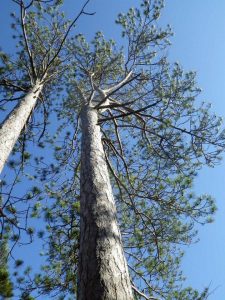“Still left out in the dark, however, are Nova Scotia’s private wood lots owners”
 Well before the American election, our softwood lumber trade with the U.S. (worth circa $85M to Nova Scotia, and $4.6 billion to Canada at large) was on shaky grounds. The last softwood lumber agreement ran out Oct 12, 2015, and the subsequent one-year litigation standstill period ran out a year later. Already the U.S. International Trade Commission has said that Canadian lumber is “subsidized and sold in the United States at less than fair value”, causing harm and the U.S. Commerce Department is conducting anti-dumping and countervailing duty investigations. (CBC, Jan 6, 2017).
Well before the American election, our softwood lumber trade with the U.S. (worth circa $85M to Nova Scotia, and $4.6 billion to Canada at large) was on shaky grounds. The last softwood lumber agreement ran out Oct 12, 2015, and the subsequent one-year litigation standstill period ran out a year later. Already the U.S. International Trade Commission has said that Canadian lumber is “subsidized and sold in the United States at less than fair value”, causing harm and the U.S. Commerce Department is conducting anti-dumping and countervailing duty investigations. (CBC, Jan 6, 2017).
With Trump’s America First policies, the old arguments of the benefits of trade for both sides hold much less weight; Canadians will have to demonstrate that U.S. imports of Canadian lumber increase jobs in the U.S., e.g. by lowering costs and stimulating U.S. housing and showing that those benefits exceed losses in competing (but more expensive) U.S. lumber suppliers.
One sign of skittishness on the Canadian side: “A free-market think tank suggests offering American negotiators in upcoming NAFTA talks more open trade in dairy, in exchange for more stable trade in softwood lumber to secure long-term peace on that perennially problematic file”. – See A dairy-for-lumber deal? Think-tank paper proposes Canada-U.S. swap for NAFTA.
Wow. Trade off our diary quotas so we can keep our lumber deal? That could be a big hit on our rural economy. Further, once the quota system is gone it would be hard to re-introduce, rendering it no longer relevant in subsequent softwood lumber trade negotiations.
The “Maritime Exclusion” exempted Maritime softwood lumber producers from quota restrictions under the 2006 and earlier softwood lumber trade agreements (on the grounds that unlike other provinces, most wood comes from private lands) but Peter McKenna, Prof of Political Science at UPEI thinks Trump is not a fan of side deals and that we will simply be lumped in with the rest of the country in any future deals.
In the meantime, a U.S. lumber lobby group has accused New Brunswick of subsidizing its softwood lumber industry and the U.S. Dept of Commerce is investigating; and the Atlantic Lumber Producers which represented industry interests for the four Atlantic provinces has disintegrated, each province now apparently pursuing its own course in representing their interests in Washington. Read more about these trade issues in the March 2017 edition of Atlantic Forestry Review*.
*AFR is available only in print form, but a subscription is very modestly priced and the magazine provides a lot of information about forests and forestry in the Maritimes that is not available elsewhere.
Then there are Nova Scotia’s more valuable, always precarious pulp and paper exports (worth $521 M in 2014). Complaints of unfair competition by the U.S. Coalition for Fair Paper Imports in 2015 resulted in countervailing duties of 20% being placed on Port Hawksbury Paper exports to the U.S. in 2015, and even the Canadian based Resolute Forest Products is claiming damages based on Dexter government deals with PHP. (Our other pulp mill, Northern Pulp in Pictou, is focussed on the Chinese market, and so has escaped U.S. scrutiny; 75-80% of PHP’s output goes to the U.S, according to a report on the ForestNS AGM in AFR for March, 2017.)
UPDATE Mar 27, 2017: For more about duties on supercalendered paper (as at PHP), view Irving Paper’s trade battle gets tougher with Trump administration (CBC)
I have to wonder whether the delay in signing a 10-year deal with WestFor for access to and management of the Western Crown Lands reflects some nervousness about how the deal could be viewed in Washington.
In a review of Nova Scotia’s Pulp & Paper Sector (Jan 2015), Peter Woodbridge expressed optimism for that sector, but noted: “Still left out in the dark, however, are Nova Scotia’s private wood lots owners—accounting for over 60% of ownership of the province’s forests.” I wonder if he still retains that optimism.
A letter from Tom Miller of Green Hill in Atlantic Forestry Review for March 2017 makes it clear things haven’t got better for private wood lots owners. “Softwood prices presently are the same as 15-20 years ago… Woodlot owners are facing stiff competition from our own crown lands, as the WestFor consortium tucks into the former Bowater land and has flooded the market and mills with wood.* This has dropped prices $10-$20 per tonne in less than a year.
Remarkably, against this backdrop Miller still retains some optimism: “the future, I believe, is in long term slow to moderate growth of our long lived Acadian forest species…This will make for a high-value forest and help you realize that soon-to-be-here latest of returns from your woodlot: carbon money…as the federal and provincial government is set to impose carbon pricing country wide.”
I hope such thoughts make their way into Ministerial and MLA discussions of how the Nova Scotia government can best address the challenges to our forest economy – and the needs of wildlife and all Nova Scotians for genuinely healthy forests.
———–
*”PULP INVENTORIES ARE EXTREMELY HIGH AT BOTH PULP MILLS. IT IS ADVISED TO AVOID HIGH % PULP STANDS AND MAKE LARGE PULP (3.5″ TOP MIN.). FURTHER STOPPAGES IN DELIVERIES ARE A POSSIBILITY .” Note on HC Haynes Nova Scotia Wood Prices for March 13, 2017
